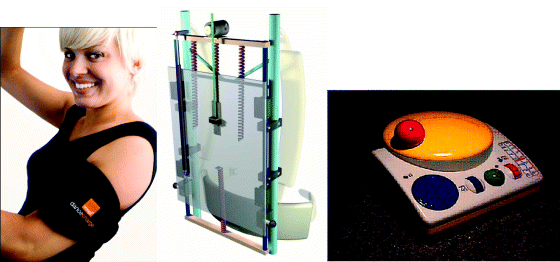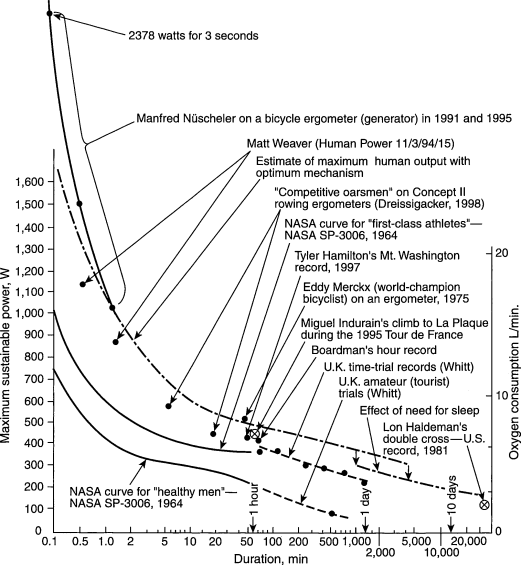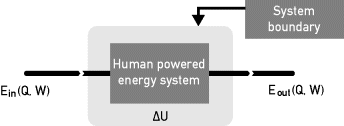3.6 Human-Powered Energy Systems
3.6.1 Introduction
Human-powered energy systems have been around since the beginning of humankind and can be seen in many forms. Section 3.6 focuses on products characterized by the presence of a technical system converting muscular work into electricity. Some examples of this type of human-powered products are the dyno-torch (a flashlight powered by squeezing it), hand-cranked flashlights, and human-powered radios. Literature provides multiple synonyms for the conversion process involved in human-powered energy systems, that is, energy scavenging, energy harvesting, power from the people, and self-powering. Human power is generally defined as a nonconventional power source and is seen as a battery alternative for electrical products.
The first human-powered product (as defined within the boundaries of this section), the human-powered flashlight or dyno-torch, was produced by Philips as early as the pre–World War II era. Although the design and engineering have evolved, similar products are produced even today. Traditionally, these products were aimed at use scenarios where the user wanted to be independent from the grid. In 1988 the first human-powered quartz wristwatch was marketed by Seiko (Auto-Quartz, later named Seiko Kinetic). A next generation of human-powered products was introduced by the BayGen company in 1995, including the BayGen radio (Figure 3.6.1).
Figure 3.6.1 From left to right: the Philips dyno torch, Seiko kinetic watch, and BayGen Freeplay radio

Product characteristics or unique selling points, as used in the sales descriptions of human-powered products, are as follows:
- Environmental benefit or eco-friendliness; human-powered products are widely perceived as more sustainable than their battery-powered alternatives.
- No batteries; consumers are attracted to the idea of not having to buy batteries, although many human-powered products do contain nonreplaceable secondary batteries or capacitors.
- Independence from the grid; since human-powered products can be used everywhere and anytime, the user experiences independence from the grid.
- Emergency preparedness; due to the self-discharge behavior of batteries, products for emergency preparedness cannot rely on them.
- Freedom in choice of power source; especially with products featuring a combination of photovoltaic solar cells, human power, batteries, and grid power, the user is able to choose the power source that best fits his or her specific requirements.
Next to products in the market (see examples in Figure 3.6.2), graduation projects at Delft University (see Jansen, 2011, chap. 8) have resulted in a plethora of ideas and concepts for the use of human power. These projects started from an environmental perspective and gradually merged toward exploiting the general user benefits of human-powered products. On the Internet, numerous examples of human-powered product concepts can be found as well (Figure 3.6.3). Many of them made it no further than a computer drawing or the prototype phase; this might be due to an absence of consumer adoption, lack of a sense of engineering reality, or even lack of knowledge of basic physics principles.
Figure 3.6.2 Examples of human-powered products from the 2010 study: Eternity Flashlights I powered by shaking (top left), an Eternal Torch small squeeze torch (middle right), a Jensen MR-550 radio (top right), an XLN288s Dynamo Flashlight (bottom left), a Kaito KA404 flashlight radio (middle bottom), and a Kaito KA218 flashlight radio (bottom right)

Figure 3.6.3 (Left to right): Orange dance charger, backpack charger (Rome et al., 2005), and My First Wind-Up Sony (DUT student project by Yannic Dekking)

3.6.2 The Human Body as a Power Source
The human body can be used in many ways to generate electric power. A first overview of this was provided in Starner (1996). It presents first estimates of the power available from exhalation, breathing bands, blood pressure, footfalls, finger motion, body heat, and arm motion. The largest power potential, however, is generated by using the muscular groups of both arms and legs to convert muscular power into electricity. Examples of various types of muscular output are provided in Table 3.6.1. Note that these values are muscular power output values; the efficiency of converting them into electricity is not included.
Table 3.6.1 Examples of muscular output.
| Type of input and input variables | Muscular power output (W) |
| Push button with thumb (as in ball point pen): 16 N @ 8 mm travel and 2 Hz repetition rate1 | 0.56 |
| One-hand squeeze: 400 N @ 30 mm travel and 1 Hz repetition rate1 | 12 |
| One-hand cranking of five different radios; average power input required2 | 5.15–21.2 |
| One-hand ergometer cranking with 175 mm crank length; sustainable cranking output for 95% of the population3 | 31 |
| One-hand ergometer cranking with 175 mm crank length; maximum power exertion from five subjects3 | 109–168 |
| Notes: (1) Adapted from Jansen and Stevels (1999); (2) adapted from Jansen (2004); and (3) adapted from Jansen and Slob (2003). | |
The total energy output is determined by multiplying the power output and duration of the task. The duration of the task, however, strongly influences the maximum power available from the user, as can be seen in Figure 3.6.4. As a rule of thumb, it can be stated that comfortable (sustainable) power levels are – in general – 15% of the maximum power output reached during short (all-out) output bursts.
Figure 3.6.4 Human power output, principally by pedaling. Curves connect the terminations through exhaustion of constant-power tests. (Wilson, 2004)

Figure 3.6.5 First law of thermodynamics for a closed system

Figure 3.6.6 Product functions, human movement, and conversion steps

3.6.3 Kinetic Energy Formulas: From General Models to Specific Models
General descriptive models from literature only partly suffice in describing human-powered energy systems in consumer products. This section presents the results of adapting existing general models in order to apply them to human-powered energy systems.
Figure 3.6.2 presents a descriptive model (closed model) of a human-powered energy system in a consumer product, focusing at the flow of energy with specified system borders, energy input (Ein) and energy output (Eout), in which
| Ein (Q, W) | Energy input; supplied by the human body |
| ΔU (Q, W) | Change in internal energy (temperature, pressure, etc.) |
| Eout (Q, W) | Energy output; electric, pneumatic, hydraulic, or mechanical work |
Given the nature of human-powered energy systems, work will be performed not only by the system but also mainly on the system. In this case, W is negative. In order to make this formula applicable for a description of models of human-powered energy systems, it is rephrased into
(3.6.1) ![]()
This equation shows how the total amount of energy into the human-powered energy systems equals the change in internal energy plus the energy output of the system. The energy input can be represented in this equation:
(3.6.2) ![]()
In which
| Ein (joule) | Energy from human work |
| Phuman(t) (Watt or J·s−1) | Power from muscular work |
The power from muscular work for (continuous) translational movements is described by this equation:
(3.6.3) ![]()
In which
| Phuman(t) (Watt or J·s−1) | Human power as a function of time |
| F(t) (N) | Force exerted by the human |
| S(t) (m) | Distance traveled |
The power from muscular work for (continuous) rotational movements is described by this equation:
(3.6.4) ![]()
In which
| Phuman(t) Watt or J·s−1) | Human power as a function of time |
| F(t) (N) | Human force exerted at the crank |
| r(t) (m) | Crank length |
| ω(t) (rad·s−1) | Angular velocity of the crank |
The energy balance as presented earlier can therefore also be captured by this equation:
(3.6.5) ![]()
In which
| Eproduct (joule) | Energy consumed by the product at time considered |
| ηa (%) | Efficiency of the total energy systems = the product of the efficiency of the various transformation steps |
| Whuman (joule) | Energy input from the user |
This equation shows that the total amount of energy provided by the human body should be equal to the amount of energy dissipated by the conversion system and the human-powered product. This energy balance provides a critical condition in assessing the feasibility of a human-powered energy system.
Practically, the energy balance will consist of the difference of the integral of both the muscular power exerted by the user and an integral of the power consumption by the product, as presented in this equation:
(3.6.6) 
In which
| ηa (a = 1 to n) (%) | Efficiency of the total energy system (Eout/Ehuman in), consisting of n steps |
| Phuman (Watt) | Power input from human muscular work |
| Pproduct (Watt) | Power consumption of the product |
The power input considered in this mathematical model is based upon active muscular power input by the user and can also be applied to “passive” power input by the user.
3.6.4 The Design of Human-Powered Energy Systems
A simple method to design a human-powered energy system is provided in this subsection. It consists of the following three steps, which will be explained in detail here:
- are always and everywhere available, and have a long shelf life;
- reduce the cost of ownership of products (no battery costs on the long run and lower maintenance cost because battery replacement is not required);
- reduce a product's environmental impact over its life cycle;
- can be used in drawing attention to other environmental initiatives (e.g., the Dance Floor project, (Randag, 2007)); and
- provide unique and innovative solutions.
Figure 3.6.7 is an example of a power graph showing an energy balance calculation. Human power input is 10 W during 30 s (t1). This means the total amount of human work is 300 J. When this energy is “stored” in a battery and the energy conversion and storage system has an efficiency of approximately 40%, 120 J is available for the product. This means that a product with a 1.8 W power consumption can now be powered during 66.7 s (t2) (Figure 3.6.7).
Figure 3.6.7 Power graph of human power and product consumption

Sankey diagrams can also be very illustrative in presenting a quantitative view on the product's conversion efficiency, as shown in Figure 3.6.8, presenting the energy system of the first BayGen Freeplay radio.
Figure 3.6.8 A Sankey diagram of the BayGen Freeplay radio energy system (the freewheel between the spring and first gear is not depicted here). The input consists of cranking 30 s at 21 W

Design recommendation do's and don'ts: During the research project into human power and also as a result of 20 graduation projects at Delft University, valuable practical insights were developed. These design recommendations are fully documented in Jansen (2011), and some of them are as follows:
Please be aware, though, that only following the steps mentioned in this section unfortunately does not guarantee a successful human-powered product. A sparkling mix of curiosity, physics, design knowledge, and a touch of creativity are at least as important to develop a successful product proposal.
3.6.5 Environmental Aspects of Human-Powered Energy Systems
Both in sales descriptions and in scientific publications, human-powered products are positioned as being environmentally beneficial. This is mainly due to the fact that not using batteries is interpreted as an environmental benefit. In this subsection, we will discuss this assumption.
On one hand, the use of a human-powered energy system reduces a product's environmental impact due to the fact that no electrical power from batteries or the grid is consumed. On the other hand, the additional components used in the human-powered energy system cause an additional environmental impact. Balancing both these effects is the key to answering the question of whether a human-powered product is really environmentally beneficial. This is best illustrated by using the Lifetime Design Strategies (LiDS) wheel (Brezet and van Hemel, 1997; see Figure 3.6.9), which provides a qualitative view on the environmental effects of various design strategies.
Figure 3.6.9 The Lifetime Design Strategies (LiDS) (Brezet and van Hemel, 1997) applied to human-powered products with respect to regular products

Introducing a human-powered energy system means additional use of materials like copper, magnets, gears, and so on, and thus lowers the score on reduction of materials and low eco-impact production, the second and third categories of the LiDS wheel. The environmental benefit is depicted in the fifth category, low eco-impact use.
Besides the straightforward LiDS approach, the answer to the question of whether human power is beneficial to the environment also has a second dimension, namely, where one should draw the system boundaries? In conventional life cycle assessment (LCA) studies based on the ISO 14000 standard, the environmental impact of human power is set to zero. One could argue whether this agreement is still valid when human power is used as a battery alternative. The energy required for growing, transporting, cooling, and displaying food is considerable, and a conversion efficiency of food to muscular power of maximum 20% makes the discussion even more difficult. Including the environmental impact of the supply chain for human food into the system boundaries significantly changes the outcomes of the environmental analysis. However, expanding the system boundaries beyond the product might lead to the discovery that calculating the environmental advantages is worthwhile. This can best be illustrated by the example of a smart door-closer system in which the closing motion of the door is damped by means of an electromagnetic system. This system converts the closing motion of the door into electricity, which is then stored in a set of batteries. These batteries can power a wireless communication system, saving the costs of installing wiring to fire doors in larger buildings (Biermann, 2001).
Even in the case of a product with significantly lower environmental performance, still the spin-off may be beneficial for the overall environmental performance. This can be seen in the design of the energy-converting dance floor. This floor was originally designed by Anouk Randag for the Sustainable Dance Club based in Rotterdam (Randag, 2007). The dance floor played a significant role in communicating the objectives of the Sustainable Dance Club by introducing the concept of sustainability to a broader audience; although the environmental performance of the product itself shows no improvement, the product had a noticeable function in communicating sustainability on a different level.
